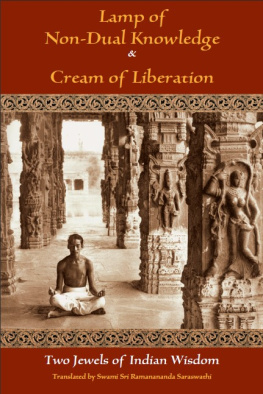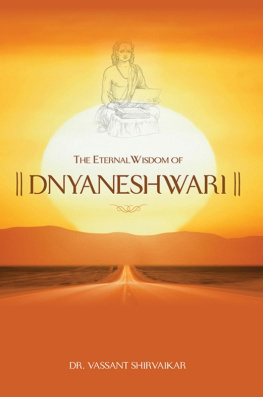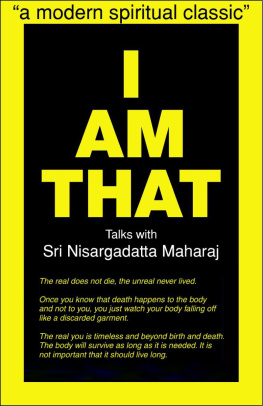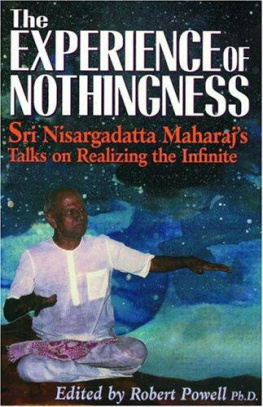Dasbodh
Spiritual Instruction for the Servant
Spiritual Discourses Between
a Master and Listeners
by
Saint Shri Samartha Ramdas
Dasbodh
Spiritual Instruction for the Servant
Spiritual Discourses Between a Master and Listeners
by
Saint Shri Samartha Ramdas
Translation by
Mrs. Shilpa Joshi and Dr. Shrikrishna Karve
Edited by David Moe
2011 Sadguru Publishing
2011, First Electronic Edition
No part of this book may be reproduced or utilized in any form or by any means, electronic or mechanical for commercial usage without written permission from Sadguru Publishing
Contact Information:
www.sadguru.us
Email: Admin at sadguru.us
Admin at dasbodh.org
Cover Art:
Original portrait of
Shri Samartha Ramdas
by David Joaquin
www.twohawkstudio.com
A Sadguru Publication
Introduction to Dasbodh
India is a land rich in spiritual and cultural heritage that has brought forth many saints and sages into this world. Many of them have left behind a legacy of spiritual literature that has been a great gift to mankind. In particular, the region that is now known as Maharashtra state has been the homeland to many of these great saints. The Jnaneshwari of Saint Jnaneshwar, the Tukaramachi Gatha of Saint Tukaram, the Ekanathi Bhagwat of Saint Eknath, and Dasbodh of Saint Samartha Ramdas are considered by many to be the Marathi equivalent of four Vedas that expound upon spiritual knowledge and the path of devotion. Samartha Ramdas is one of the most highly revered saints of Maharashtra who has a vast amount of literature to his credit. Dasbodh is regarded as the crown jewel of the writings attributed to Shri Samartha Ramdas.
This greatly treasured classic text has now become available in English to non-Marathi speaking spiritual seekers and aspirants so that they may be benefitted by the comprehensive exposition of instruction given by Shri Samartha Ramdas on how to succeed and excel in both worldly life and spiritual life. According to historical accounts, the content of this book was originally dictated by Samartha Ramdas to his disciple Shri Kalyan Swami. Afterwards, copies of the text were distributed to various monasteries founded by Samartha Ramdas where they were further prepared and then recorded for the masses by some of his main disciples.
Dasbodh is a large volume that is comprised of two hundred chapters which are divided into twenty main chapters called Dashaka, each consisting of ten sub-chapters called Samasa. Each of the sub-chapters has a varying number of stanzas that were composed in a meter form called Ovi. The original Marathi text was written in a poetic style that was not only spoken, but was usually sung. Even in this modern age, in many towns and villages in Maharashtra state in India, Dasbodh is still widely being sung on a daily basis. It is now even possible to find recordings on the internet of Dasbodh being sung in Marathi. Dasbodh is an original text in the sense that it is not a commentary on any Sanskrit books that were written prior to it. Although it is supported by the authority of many scriptures, it is mainly the voice of direct experience.
The book is written in the style of questions and answers between a Master and listeners, among whom were several knowledgeable disciples that were familiar with the finer subtle aspects of Advaita Vedanta teachings. This English translation is presented in a free prose style. It is simply not possible to capture the poetic style, or meter and rhyme of the original Marathi text in a modern-day English translation. However, great efforts have been made to ensure that the correct meaning that Samartha Ramdas intended to convey is accurately being presented to you the reader. It is also not possible to give an exact translation from the original text, as it was written in what is now called "Old Marathi," which is not spoken anymore, however there are many modern Marathi language editions available, so every attempt has been made to keep as close as possible to the original wording that appears in those Marathi texts.
Three English translations of Dasbodh have been used as reference when editing this book. Two word-for-word translations containing the Marathi transliterations where specifically commissioned for this book, and a third translation, which was published shortly after those two translations were completed in 2004, was also used. The two word-for-word translations were done between the years 2002 and 2004 by Dr. Shrikrishna Karve and Mrs. Shilpa Joshi. The third translation that was used, which does not include the word-for-word Marathi transliteration, was done by the venerable Shri Diwakar Ghaisas who has also done many other English to Marathi, and Marathi to English translation projects on Advaita Vedanta and other spiritual topics. Because of his expertise and knowledge of the subject matter, the translation of Shri Ghaisas has been particularly helpful in making determinations of the meaning that Samartha Ramdas was intending when the two word-for-word translations were not in agreement. Not being a native speaker of the Marathi language myself, I am very grateful that his translation was available to provide a degree of certain clarity that may have been lacking otherwise.
If the readers or any scholars find some error in the text (and surely there will be some in this first edition), know that mistake to be mine only. Additionally, the readers are asked not to harbor any negative thought towards Dasbodh or Samartha Ramdas because of any perceived shortcomings. I welcome any knowledgeable people to present any perceived errors in this text for consideration for correction in a future edition of this book. As for commentary, it is often seen that spiritual texts such as this are filled with commentary about each and every line or stanza, but you will not find any such heavy commentary in this book. I feel that the words of Samartha Ramdas stand clear on their own, and for the most part do not need much additional commentary.
Dasbodh presents teachings about many subjects in a methodical and orderly manner. The reader is strongly encouraged to read the text completely from beginning to end at least once, as this is how it is intended to be read or heard. Many of the more subtle points and principles presented in the text build upon points that have been explained previously. By skipping around the text, some benefit will surely be gained, but without having an understanding of points that have been made previously, some confusion will naturally occur in the reader's mind. To this day, Dasbodh is read from beginning to end in many households and monasteries across India and then it is reopened to be reread and studied from the beginning again. In this way, its pages always remain open to provide lessons in daily life.
The editing style of this book has been tailored for the minds of western readers who may not be familiar with Sanskrit or Marathi terms. The intention behind the style of editing that has been used is to help ensure that any serious aspirant, regardless of their background, may be able to understand without having any familiarity with Indian terms and phrases. This has been a challenging task because many of the words used in the text simply have no English equivalent. For the benefit of aspirants who wish to study a bit more in-depth, some Sanskrit and Marathi words have been included, mostly in-line, in parentheses, following the English word. This style has been adopted in order to minimize the use of footnotes, so as not to distract the reader's attention away from the points being made. As this book is an English translation, for the most part, the English words appear in the sentences and the Indian words are in parenthesis, rather than the other way around. The intent behind this is to try as much as possible not to confuse the minds of English speaking readers with foreign words. However, it should be said that if the reader can become comfortable with the foreign words, it will surely be an aid to a more subtle understanding. If there are many requests, a word-for-word transliterated version of the text may be made available for the student who is familiar with Marathi or Sanskrit and wishes to try to gain a deeper understanding through the Indian words. Because of the size of Dasbodh , it is not really practical to offer a word-for-word transliteration here in this book. Any such work would certainly need to be broken up into three or four large volumes, possibly in a workbook format.












